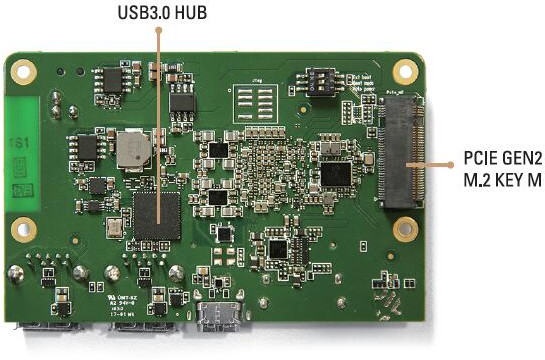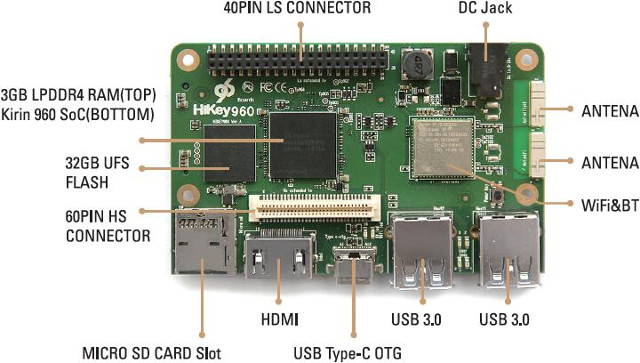The most powerful 96boards development board – HiKey 960 – has finally been launched, and can be purchased for $239 on Aliexpress, Amazon US, Switch Sense (Japan), Seeed Studio, or All Net (Germany).
HiKey 960 specifications have not changed much since we found out about the board:
- SoC – Kirin 960 octa-core big.LITTLE processor with 4x ARM Cortex A73 cores @ up to 2.4 GHz, 4x Cortex A53 cores @ up to 1.8 GHz, and a Mali-G71 MP8 GPU
- System Memory – 3GB LPDDR4 SDRAM (PoP)
- Storage – 32GB UFS 2.1 flash storage + micro SD card slot
- Video Output / Display Interface – 1 x HDMI 1.2a up to 1080p, 1x 4-lane MIPI DSI connector
- Connectivity – Dual band 802.11 b/g/n/ac WiFi and Bluetooth 4.1 with on-board antennas
- USB – 2x USB 3.0 type A host ports, 1x USB 2.0 type C OTG port
- Camera – 1x 4-lane MIPI CSI, 1x 2-lane MIPI CSI
- Expansion
- PCIe Gen2 on M.2 Key connector
- 40 pin low speed expansion connector with +1.8V, +5V, DC power, GND, 2x UART, 2x I2C, SPI, I2S, 12x GPIO
- 60 pin high speed expansion connector: 4L MIPI DSI, 2L+4L MIPI CSI, 2x I2C, SPI (48M), USB 2.0
- Misc – LEDs for WiFi & Bluetooth, 4x user LEDs, power button, copper heatsink for CPU
- Power Supply – 8V-18V/2A via 4.75/1.7mm power barrel (EIAJ-3 Compliant); 12V/2A power supply recommended; PMU: Hi6421GWCV530, Hi6422GWCV211, Hi6422GWCV212;
- Dimensions – 85mm x 55mm
 The board officially supports Android Open Source Project (AOSP) with Linux 4.4. Binary images, and instructions to build from source are available in the Documentation page. You’ll also find the hardware manual and schematics over there. There’s no firm commitment to a Linux distributions release, but based on comments from the launch video (embedded below), there could be some later on, and Linux mainline is also being worked on. Stocks are currently limited so you can buy one or two boards, but larger quantities would require a longer lead time. LeMaker also mentions kits with power supply, mini PCIe card… being available soon.
The board officially supports Android Open Source Project (AOSP) with Linux 4.4. Binary images, and instructions to build from source are available in the Documentation page. You’ll also find the hardware manual and schematics over there. There’s no firm commitment to a Linux distributions release, but based on comments from the launch video (embedded below), there could be some later on, and Linux mainline is also being worked on. Stocks are currently limited so you can buy one or two boards, but larger quantities would require a longer lead time. LeMaker also mentions kits with power supply, mini PCIe card… being available soon.
The video will eventually be uploaded to YouTube, but in the meantime I’ve embedded the Facebook video.

Jean-Luc started CNX Software in 2010 as a part-time endeavor, before quitting his job as a software engineering manager, and starting to write daily news, and reviews full time later in 2011.
Support CNX Software! Donate via cryptocurrencies, become a Patron on Patreon, or purchase goods on Amazon or Aliexpress





